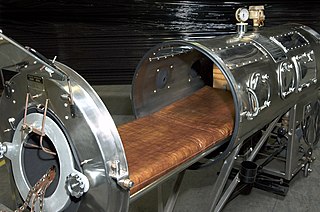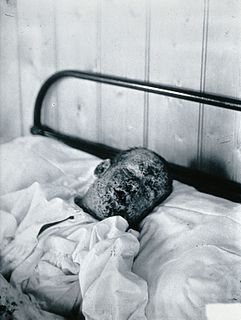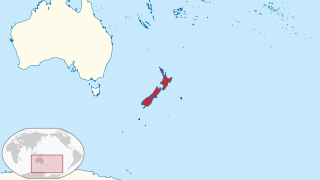
A pandemic is an epidemic of an infectious disease that has spread across a large region, for instance multiple continents or worldwide, affecting a substantial number of people. A widespread endemic disease with a stable number of infected people is not a pandemic. Widespread endemic diseases with a stable number of infected people such as recurrences of seasonal influenza are generally excluded as they occur simultaneously in large regions of the globe rather than being spread worldwide.

Measles is a highly contagious infectious disease caused by measles virus. Symptoms usually develop 10–12 days after exposure to an infected person and last 7–10 days. Initial symptoms typically include fever, often greater than 40 °C (104 °F), cough, runny nose, and inflamed eyes. Small white spots known as Koplik's spots may form inside the mouth two or three days after the start of symptoms. A red, flat rash which usually starts on the face and then spreads to the rest of the body typically begins three to five days after the start of symptoms. Common complications include diarrhea, middle ear infection (7%), and pneumonia (6%). These occur in part due to measles-induced immunosuppression. Less commonly seizures, blindness, or inflammation of the brain may occur. Other names include morbilli, rubeola, red measles, and English measles. Both rubella, also known as German measles, and roseola are different diseases caused by unrelated viruses.

A ventilator is a machine that provides mechanical ventilation by moving breathable air into and out of the lungs, to deliver breaths to a patient who is physically unable to breathe, or breathing insufficiently. Modern ventilators are computerized microprocessor-controlled machines, but patients can also be ventilated with a simple, hand-operated bag valve mask. Ventilators are chiefly used in intensive-care medicine, home care, and emergency medicine and in anesthesiology.

An iron lung, also known as a tank ventilator or Drinker tank, is a type of negative pressure ventilator (NPV); a mechanical respirator which encloses most of a person's body, and varies the air pressure in the enclosed space, to stimulate breathing. It assists breathing when muscle control is lost, or the work of breathing exceeds the person's ability. Need for this treatment may result from diseases including polio and botulism and certain poisons.
Vaccine hesitancy, also known as anti-vaccination or anti-vax, is a reluctance or refusal to be vaccinated or to have one's children vaccinated against contagious diseases despite the availability of vaccination services. It was identified by the World Health Organization as one of the top ten global health threats of 2019. The term encompasses outright refusal to vaccinate, delaying vaccines, accepting vaccines but remaining uncertain about their use, or using certain vaccines but not others. Arguments against vaccination are contradicted by overwhelming scientific consensus about the safety and efficacy of vaccines.

Francisco Tiongson Duque III is a Filipino physician and government official serving as Secretary of Health since 2017 in the Cabinet of President Rodrigo Duterte, a position he had previously held from 2005 to 2010 in the Cabinet of President Gloria Macapagal Arroyo. From 2010 to 2015, he served as the Chairman of the Civil Service Commission.

Eradication is the reduction of an infectious disease's prevalence in the global host population to zero. It is sometimes confused with elimination, which describes either the reduction of an infectious disease's prevalence in a regional population to zero, or the reduction of the global prevalence to a negligible amount. Further confusion arises from the use of the term eradication to refer to the total removal of a given pathogen from an individual, particularly in the context of HIV and certain other viruses where such cures are sought.

Public health in Niger suffers from a chronic lack of resources and a small number of health providers relative to population. Some medicines are in short supply or unavailable.

Measles is extremely contagious, but surviving the infection results in lifelong immunity, so its continued circulation in a community depends on the generation of susceptible hosts by birth of children. In communities which generate insufficient new hosts the disease will die out. This concept was first recognized by Bartlett in 1957, who referred to the minimum number supporting measles as the critical community size (CCS). Analysis of outbreaks in island communities suggested that the CCS for measles is c. 250,000.

The 2019 Philippines measles outbreak began in early 2019. An outbreak of measles was officially declared in February 2019 in select administrative regions in Luzon and Visayas including Metro Manila by the Philippine government. The outbreak is attributed to lowered vaccination rates, from a high of 88% 10 to 15 years previous to 74% at the time of the outbreak, allegedly caused by the Dengvaxia controversy.
The 2019 measles outbreaks refer to a substantial global increase in the number of measles cases reported, relative to 2018. As of April 2019, the number of measles cases reported worldwide represented a 300% increase from the number of cases seen in the previous year, constituting over 110,000 measles cases reported in the first three months of 2019. In the first half of 2019, the World Health Organization received reports of 364,808 measles cases from 182 countries, up 182% from the same time period of 2018 when 129,239 confirmed cases were reported by 181 countries.
The 1990–1991 Philadelphia measles outbreak was a medical event in and around Philadelphia, Pennsylvania, in which over 1,400 people, mostly children, became sick with measles, and nine children died. There were two epicenters for this outbreak within the area: The Faith Tabernacle Congregation and the First Century Gospel Church. Both churches discouraged the use of not only vaccinations, but also all other forms of medical treatment, instead relying solely on faith healing. Following an investigation into the death of the first victim of the outbreak, a court order was obtained to forcibly treat and vaccinate children whose parents would not agree to seeking medical care. Nine children eventually died as a result of this outbreak.
In early September 2018, cases of measles began to appear in Antananarivo, Madagascar. Capitol health authorities challenged by the district's poverty and Madagascar's relatively-low vaccination rate were unable to contain the highly-contagious disease, and what followed became the largest measles outbreak yet in Madagascar's history. With more than 115,000 people infected and more than 1,200 dying, the outbreak has become Madagascar's most serious outbreak of measles in the 21st century.

The 2019–2020 New Zealand measles outbreak refers to an ongoing epidemic affecting New Zealand, though primarily in the Auckland region. The outbreak was the worst epidemic in New Zealand since an influenza epidemic in 1999, and is the worst measles epidemic since 1938. The Measles outbreak of 1999 was actually predicted two years prior. An "immunization campaign" was intended to vaccinate 90–95% of New Zealand, but ultimately failed as less than 80 percent of New Zealand's population was vaccinated, resulting in the epidemic. Australia has been linked to the New Zealand epidemic. An ongoing outbreak in Perth began in October 2019 after a New Zealander visited while infectious.
The 2019–2020 Philippines polio outbreak is an ongoing epidemic. For the past 19 years, the Philippines was freed of any polio-related diseases. It was until September 14, 2019, when the disease began to resurface again through a positive test result done to a 3-year-old girl from the southern Philippines. After the confirmation of a second case from tests done on a 5-year-old boy, the government of the Philippines publicly declared the polio outbreak on September 19, 2019.

In 2019, a measles epidemic broke out in the Democratic Republic of the Congo (DRC). The epidemic started in early 2019 in the southeast corner of the DRC and then spread to all provinces. By June 2019 the epidemic was reported to have exceeded the death toll of the concurrent Ebola epidemic. By April 2020, it had infected more than 341,000 people and claimed about 6,400 fatalities. This has primarily affected children under the age of five, representing 74% of infections and nearly 90% of deaths.

The 2019 Samoa measles outbreak began in September 2019. As of 6 January 2020, there were over 5,700 cases of measles and 83 deaths, out of a Samoan population of 200,874. Over three percent of the population were infected. The cause of the outbreak was attributed to decreased vaccination rates, from 74% in 2017 to 31–34% in 2018, even though nearby islands had rates near 99%.

The 2019 Tonga measles outbreak began in October 2019 after a squad of Tongan rugby players came back from New Zealand. The epidemic as of December 8 is currently ongoing. As of January 5, there have been 612 cases of measles.
Michael Joseph Ryan is an Irish former trauma surgeon and epidemiologist specialising in infectious disease and public health. He is executive director of the World Health Organization's Health Emergencies Programme, leading the team responsible for the international containment and treatment of COVID-19. Ryan has held leadership positions and has worked on various outbreak response teams in the field to eradicate the spread of diseases including bacillary dysentery, cholera, Crimean–Congo hemorrhagic fever, Ebola, Marburg virus disease, measles, meningitis, relapsing fever, Rift Valley fever, SARS, and Shigellosis.

Ayesha Jennifer Verrall is a New Zealand politician, infectious diseases physician, and researcher with expertise in tuberculosis and international health. She is a senior lecturer at the University of Otago, Wellington, and since 2019 has been a member of the Capital and Coast District Health Board. During the 2019–20 coronavirus epidemic, she provided the New Zealand Ministry of Health with an independent review and recommendations for its contact tracing approach to COVID-19 cases.













